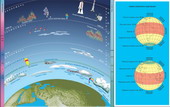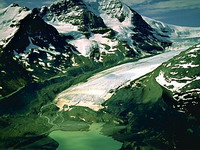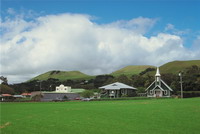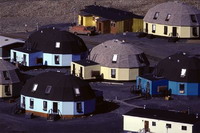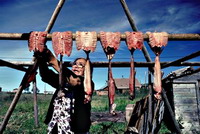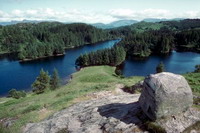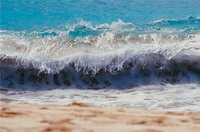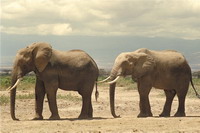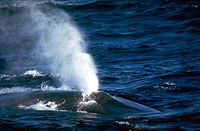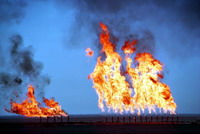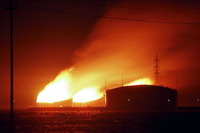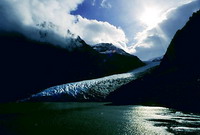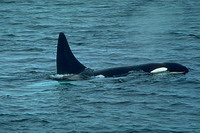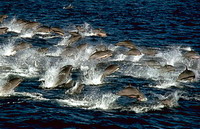An aerial shell that surrounds the Earth and rotates with it, called the atmosphere. Earth's atmosphere - a mixture of many gases, which hung in a state of contained solid and liquid particles: dust, ashes and soot. Ground layer of air consists of 78% nitrogen, 21% oxygen and 1% other gases.
The limits of the atmosphere is difficult to establish precisely. Lower boundary is the surface, but keep in mind that air penetrates into all cracks and pores of rocks. The upper limit is about 3000 km altitude, but the air is so thin that talk about a solid shell is no longer available. The atmosphere is composed of five layers. In the lower layers - the troposphere concentrated 90% of the total weight of the air and almost all water vapor. It formed the clouds and precipitation falls. The upper limit of the troposphere on the height of 8 km in polar latitudes and 18 miles - near the equator. Above the troposphere - stratosphere, which extends to 50 km above the earth's surface. In the stratosphere, air has a much lower density compared to the troposphere. Here is the ozone layer that protects Earth from the harmful effects of space radiation. Mesosphere, thermosphere and exosphere is the upper layers of the atmosphere with a very thin air and significant fluctuations in temperature. In the troposphere temperature decreases by 0.6 degrees every 100 m rise up. In the stratosphere is the reverse process, the temperature rises by 1-2 degrees with each kilometer. In the mesosphere the temperature again decreases up to the mark - 100 ° C. Next is a constant fever.
Physical state of the lower layer of the atmosphere at a particular time in a particular area is called weather. Weather is defined by six basic parameters: temperature and air humidity, atmospheric pressure, speed, strength and direction of wind, cloudiness and precipitation.
The main source of life on Earth is the sun. On Earth comes dvomilyardna a part of this energy, the other - scattered in outer space. Falling on the Earth's surface, sunlight heats it, and already heated air from the surface troposphere. That is why the air temperature decreases with height. Changing it and within days. It is highest at 14 o'clock, and lowest before dawn. The temperature also depends on latitude, since the larger the angle of sunlight and the higher the sun, the temperature is higher. The difference between the highest and lowest temperatures is called the amplitude of temperature. Annual temperature amplitude increases from the equator to the poles. At the equator it is only 1 ° C, and in our latitudes 25-30 ° S.
Atmospheric air is easy. One cubic meter of air weighs 1 kg 300 g. However, air exerts pressure on all subjects and organisms on the Earth's surface. This pressure is called atmospheric. Each of us air pressure pillar weighing about 15 tons Pressure is measured using the barometer. The first barometer was the mercury, and was a sealed meter on one side of a glass tube filled with mercury and immersed in a bowl of this liquid. At latitude 45 °, at sea level at 0 ° C height of mercury column barometer is 760 mm. Such pressure was adopted as a normal atmosphere. Much more convenient to use for mercury is aneroid barometer, which is a metal box with pumped air. When increasing the pressure zdavlyuyetsya bottom boxes, while reducing - or vice versa. This change fixes an arrow pointing to the scale value of atmospheric pressure in mmHg. At every 100 m rise atmospheric pressure decreases by 10 mmHg.
Nahrivayuchys, the air expands, becomes lighter and rises up. Thus the surface pressure decreases. When air cools, it is styskayuchys becomes harder and more pressure is lowered to the surface. Air masses are constantly moved from areas of high pressure in the area of low pressure. Such horizontal movement of air is called wind. On the coast, large reservoirs observed breeze - wind, who twice a day, changing its direction. By day he is blowing from the sea on dry land, dry land because under sunlight heats up faster and the pressure falls on him. Day - on the contrary. There are seasonal winds - monsoons. Monsoon blowing from the sea on dry ground in the summer and bring a lot of rain, as moist air over the sea. Winter monsoon blowing from land to sea and bring dry weather. The cause of the formation of monsoons and the same as in the formation of spray - uneven heating rate of the sea and land.
Wind power depends on its speed, which is determined by a special device - the anemometer. Determine wind speed in m / s, and strength - in points. Lack of wind called the calm and the wind force 12 points when the speed exceeds 29 m / s - a hurricane. Direction of the wind can be determined using wind vane. Flyuherka (arrow weathercock) always indicates there where the wind blows. This direction is called a direction of the wind.
In the troposphere contains a lot of water vapor. Humidity is measured in grams per 1 cubic meter. It depends on the temperature. The more warm air, the more moisture it can contain. There are absolute and relative humidity. Absolute humidity - the maximum number of water vapor, which may be contained in unit volume of air at a certain temperature. It is lowest in Antarctica - the fate of one hundredth grams in 1 cubic meter of air, the largest in the equatorial zone - more than 23 g / m cu. In Ukraine, the figure is the average in January - 3 g / m cu. In July -12 g / m cu. Relative humidity - is the actual content of water vapor in the air to the maximum possible at a given temperature, expressed as a percentage. The highest relative humidity in the morning, the lowest - in the afternoon. Measure the relative humidity hygrometer.
The temperature in the troposphere decreases. There comes a time when the saturated moist air can not hold water vapor in itself and it condenses, turning into water droplets that hang in the air. If temperatures below 0 ° C, the droplets are converted into small crystals of ice. Cluster suspended in the atmosphere of small water droplets or ice crystals are called clouds, and the degree of coverage is called the sky clouds cloudy. There are many types of clouds, but occur most frequently layered, dense and cirrus clouds. Layered clouds hanging low over the land, densely covering the sky. Fog and stratus are common. Cumulus is at a height of 2-3 km. They are like pieces of cotton wool. Large number of them indicates possible precipitation. Cirrus clouds occur at altitudes above 6 km. They are translucent and resemble a bird's feathers. Their presence indicates a change in the weather. Clouds defined in points, from 0 in fair weather and 10 for complete lingering clouds of heaven.


Water that falls from clouds or directly from the air, liquid or solid form, is called precipitation. To liquid precipitation includes rain, dew, fog, hard to - hail, snow, frost. Measured precipitation layer of water (in mm) that formed when water is not flowing and does not evaporate. Used for this device - opadomir. To determine the thickness of the snow used snihomirnu rail.
Many weather regime in the area known as climate. Because of the uneven heating of the earth's surface climate in different parts of the world is very different. Earth's spherical form, tilting the axis of rotation and the annual motion around the sun causes uneven heat input to different parts of the globe. Most of the equatorial heat gets the least - Circumpolar. Depending on the amount of heat that comes to Earth, the entire surface divided into thermal zones or zones of solar lighting. Allocate tropical, two moderate (North and South) and two polar (North and South) zone. The whole territory of Ukraine within the Northern temperate thermal zone (belt light).
 English
English


